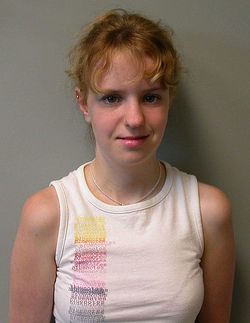Jacobsen Syndrome
Original Editor -
Lead Editors
Jacobsen Syndrome in General:[edit | edit source]
Jacobsen syndrome (JS) is a rare contiguous gene syndrome caused by partial deletion of the long arm of chromosome 11 (1). It was first described by Jacobsen in 1973[1].
Clinical Presentation[edit | edit source]
- · Growth retardation: weight and height below the 5th percentile[1].
- · Craniofacial dysmorphism: trigonocephaly, high prominent forehead, flat occiput, thin and brittle hair, down slanting palpebral fissure, palpebral ptosis, epicanthal folds, iris coloboma, arched eyebrows, hyper telorism, small and low set ears, short nose with large and depressed nasal bridge, anteverted nostrils, down turning corners of the mouth, large mouth, high palate, dental anomalies, micrognathia[1].
- · Limbs anomalies: brachydactyly, clinodactyly, comptodactyly, bilateral simian crease, clubfoot, muscular atrophy, stiff joints, pectus excavatum, dorsal scoliosis, lumbar lordosis[1].
- · Neuromotor and psychiatric disabilities: delayed standing and walking, language learning difficulties, compulsive, hetero-aggressive and auto-aggressive behavior[1].
- · Additional signs and symptoms appears in puberty: primary amenorrhea, genital infantilism, repeated episodes of sinusitis[1].
- · Syndromic primary immune deficiency (SPID)[2].
Diagnostic Procedures[edit | edit source]
Diagnosis is based on clinical findings (thrombocytopenia, intellectual deficit, and facial dysmorphic features) and must be confirmed by cytogenetics analysis[3].
Management[edit | edit source]
Jacobsen syndrome is a chromosomal disorder in which children with JS will have a global developmental delays, presented by delayed motor and speech milestones. Hence, they should be referred to physical and/or occupational therapists in order to overcome the motor developmental delay[4].
Intensive neurodevelopmental treatment (Bobath approach) three times weekly, 60 minutes a day, for 3 months is recommended as it shows improved gross motor function and higher compliance than conventional NDT[5].
Differential Diagnosis[edit | edit source]
Some of the clinical features of children with Jacobsen syndrome are shared with Tuner and Noonan syndrome; such as short and wide neck, short stature, ptosis, pulmonary or aortic stenosis, and down-slanting palpebral fissure. Some children with JS have had clinical diagnosis of Kabuki syndrome due to mental retardation, unusual palpebral fissures, short stature, and finger-pads[3].
References[edit | edit source]
- ↑ 1.0 1.1 1.2 1.3 1.4 1.5 JURCĂ AD, Kozma K, Ioana M, STREAŢĂ I, PETCHEŞI CD, Bembea M, JURCĂ MC, CUC EA, Vesa CM, BUHAŞ CL. Morphological and genetic abnormalities in a Jacobsen syndrome. Rom J Morphol Embryol. 2017;58(4):1531-4.
- ↑ 1. Dalm VA, Driessen GJ, Barendregt BH, van Hagen PM, van der Burg M. The 11q terminal deletion disorder jacobsen syndrome is a syndromic primary immunodeficiency. Journal of clinical immunology. 2015 Nov 1;35(8):761-8.
- ↑ 3.0 3.1 Mattina T, Perrotta CS, Grossfeld P. Jacobsen syndrome. Orphanet journal of rare diseases. 2009 Dec;4(1):9.
- ↑ Noritz GH, Murphy NA. Motor delays: early identification and evaluation. Pediatrics. 2013 May 27:peds-2013.
- ↑ Lee KH, Park JW, Lee HJ, Nam KY, Park TJ, Kim HJ, Kwon BS. Efficacy of intensive neurodevelopmental treatment for children with developmental delay, with or without cerebral palsy. Annals of rehabilitation medicine. 2017 Feb 1;41(1):90-6.







